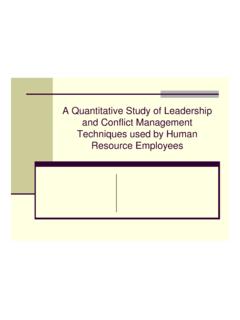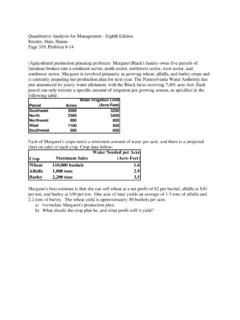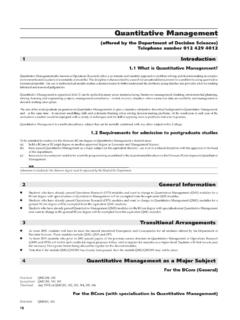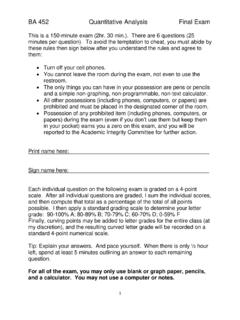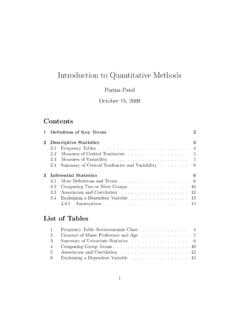Transcription of The Role and Function of Quantitative Methods in Health ...
1 Chapter 1 The Role and Function of Quantitative Methods in Health Services ManagementLearning ObjectivesAfter studying this chapter, you should be able to: . Describe how Health services managers analyze, design, and implement in a systems Differentiate between efficiency and effectiveness as vital managerial Describe how Quantitative Methods fit into the repertoire of the Health services Describe the general systems model in relation to Health Objective 1: examine HOw Health services managers anaLyze, Design, anD impLement in a systems cOntextHealth administration, as a profession, deals with the management of human, fiscal, physical, and information resources to meet the goals and objectives of healthcare organizations. Survival of the healthcare organization in a competitive environment, as well as characteristics of this survival, involve multiple factors, including the abilities of managers. The challenge is to provide healthcare orga-nizations, and the communities, patients, and clients they serve, with competent managers able to perform the robust and challenging role of a competent manager in a healthcare organization means fundamentally different things depending upon specific role expectations, perspective, and cir-cumstance.
2 Within a healthcare organization, managers are assigned very different functions , each with potentially different definitions of core competency. Manag-ers in the human resources department of a hospital face different management challenges than the managers in the hospital s planning and marketing department or the financial services department. Different types of healthcare organizations Jones and Bartlett Publishers, LLC. NOT FOR SALE OR DISTRIBUTIONmay require different types of managers. Nursing homes may require managers with different skills and values than public Health clinics. Healthcare organiza-tions also may shift their definition of desired or needed management competency because of a shift in their objectives, in characteristics in their environment, or in both. A hospital in the process of affiliating with a regional healthcare system may require different management talents than the hospital intending to remain a solo institution. Definitions of management competency also may change based upon perceived or real changes in the field of management .
3 The competencies expected of professional Health services managers encompass a very wide breadth and depth of potential responsibilities, values, interests, and abilities. Health administrators need a broad repertoire of skills to Function in this dynamic situation. More specifi-cally, multiple perspectives also exist concerning the role and Function of the Health manager in a contemporary healthcare organization. Being able to use quantita-tive Methods designed to assist managers make decisions is one essential part of this repertoire, regardless of the role and Function of any Health services manager. Figure - is one framework able to integrate many of these perspectives and is based upon the simple recognition that managers need the ability to analyze, design, and , as a core managerial competency, is the ability to discover what is. It involves, for example, discovering the current market share of an organiza-tion. It involves discovering the actual total cost of a specific service rendered by the organization.
4 It involves discovering who does what with what resources to provide a specific service. It involves using forecasting to discover the logical or reasonable future of the organization. The key and defining aspect of analysis is discovery. Sometimes discoveries shift the organization s goals and objectives. Other times discovery is used to determine whether the organization is meeting and how it is meeting its goals and objectives. To facilitate discovery, Quantitative Methods provide the manager an analytical road map. Each Quantitative method has a unique analytical ability. For example, a method such as queuing theory can only be used to analyze specific types of waiting lines. When incorporated into the manager s repertoire, Quantitative Methods provide the manager with useful and robust , as a core management competency, is the ability to identify and arrange resources in a manner commensurate with goals and objectives. If the goal is to provide a specific service, managers need to be able to design (or redesign) the mix of resources needed to provide the service.
5 The goal of operating a short-stay surgical unit in a hospital requires that a manager identify and arrange the AnalyzeDesign or RedesignImplementFigure 1-1 General management Competencies2 Chapter : The Role and Function of Quantitative Methods Jones and Bartlett Publishers, LLC. NOT FOR SALE OR DISTRIBUTION resources needed to realize the goal, such as specialized equipment and staff. If the goal is for the organization to retain specific information, then managers must be able to design work processes to capture, report, and store the desired informa-tion. Design as a managerial competency often involves engineering because it encompasses the ability to break down desired capabilities, such as an organiza-tion s goals and objectives, into requisite components or parts. If the organization desires a new service, it is a manager s responsibility to design the service by first determining the different mix of human, fiscal, physical, and information resources needed to provide the service, and then specifying exactly how much of each will be needed to provide the service.
6 Design of new work processes, or the redesign of existing ones, involves developing detailed plans so that when the plans are executed the desired capability has been incorporated into the organization. Design also involves developing these detailed plans as to what is needed as well as how the needed resources should be used. Design is performance oriented; the new or revised design must establish the desired performance , as a core management competency, is the ability to change the organization. The process of implementation may require the manager to change the behavior of specific employees. It may also involve the ability of the manager to accumulate and operationalize the resources necessary to achieve desired goals and objectives. Whereas design may be the management competency that deter-mines what is needed, implementation is the management competency that installs new or revised elements in the organization. The manager s repertoire needs to include Quantitative Methods to assist implementing change within the organiza-tion.
7 These Methods include, for example, Program Evaluation Review Technique (PERT). The Program Evaluation Review Technique is a formal method used by managers to plan and control projects. It informs managers of the desired order and schedule of activities needed to be accomplished to realize the overall completion of a project or change within the organization, such as the opening of a new short stay surgical unit in a Objective 2: tO DiFFerentiate between eFFiciency anD eFFectiveness as Key manageriaL interestsmanaging in the Health services OrganizationA healthcare organization is any organization that provides Health and medical services to patients, residents, and clients, such as an acute care or specialty hos-pital, a nursing home, an ambulatory care organization, such as a university Health services, public Health clinic, and a home Health agency. The defining characteris-tic in this definition of a healthcare organization is patient care; care provided by Learning Objective 2 3 Jones and Bartlett Publishers, LLC.
8 NOT FOR SALE OR DISTRIBUTION4 Chapter : The Role and Function of Quantitative Methodsphysicians, nurses and therapists to prevent and treat disease or infirmity. The mis-sion of these organizations serves to distinguish them as healthcare provided to patients could include a surgical procedure, diagnostic examination, specialized treatment, or disease prevention or screening program. These services also could be an appropriate meal, a safe and comfortable envi-ronment, or an accurate and timely bill for service. All healthcare organizations provide a range of services and specialize in providing individual patients a par-ticularized array of services based upon a patient s needs or diagnosis. The central and defining element of all healthcare organizations is the provision of a personal and personalized experience, and high quality Health or medical service. As such, a central expectation shared by all Health administrators is the expectation that management practice will lead to the efficient provision of effective services to people in need of interests of managers and the interests of the healthcare organizations that employ Health administrators as managers are difficult to distinguish.
9 Both interests emphasize that patients receive needed services and that services are provided in an efficient manner. Healthcare organizations and Health administrators rely upon phy-sicians, nurses, and therapists to determine or diagnosis the needs of a patient accu-rately and to plan and execute an intervention or treatment that has some probability of success in maintaining or improving the Health status of the patient. Clinical interests stress the needs of individual patients and the identification of appropriate service interventions. Decisions made by clinicians are based upon what they con-sider to be effective approaches, interventions that have some probability of clinical or medical success. The physician, nurse, or therapist has been educated and trained to select and apply current knowledge to assist patients. Clinical interests and per-spectives are focused on the effectiveness of a service the ability of a service to accomplish its predetermined objective.
10 Although clinicians are not necessarily oblivious or insensitive to efficiency, their unique role and Function stem from their commitment to provide effective service to patients. They alone have the expertise to determine a patient s needs ( , diagnosis) and to meet them ( , treatment) and are judged by their peers, specific systems, and patients based upon their ability to provide an effective, but not necessarily an efficient, as a management interestEfficiency is the ratio measure of output over input. High efficiency is achieved when a service is rendered using the least amount of resources. Inefficient clinical practice, such as requiring more clinical tests than necessary to make an accurate diagnosis can lead to a highly inefficient healthcare organization. Using more medical supplies than needed or even stocking more medical supplies than needed are other examples of operational inefficiency. Using an excess number of people Jones and Bartlett Publishers, LLC.










